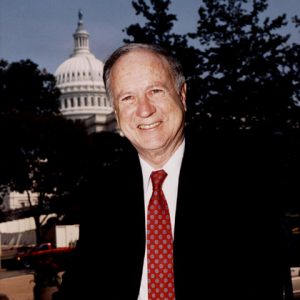calsfoundation@cals.org
U.S. Term Limits Inc. v. Thornton
The case U.S. Term Limits, Inc. v. Thornton (514 U.S. 779, 1995) began as a conflict over term limitations placed on those elected to the House of Representatives (three terms in office) and the U.S. Senate (two terms in office) from the state of Arkansas. It ended with the U.S. Supreme Court interpreting the role of the states in the federal structure created by the U.S. Constitution. The Court resolved the dispute by ruling that the qualifications for those elected to the U.S. Congress listed in the U.S. Constitution are exclusive. Thus, states may not impose additional qualifications upon candidates for the U.S. Congress either directly, or, as in the case of Arkansas, indirectly.
Arkansas imposed term limitations through Amendment 73, a ballot measure adopted in the general election of 1992. Arkansas’s limitations came in the form of ballot-access restrictions similar to those imposed by twenty-two other states during the same period. Amendment 73 prohibited the name of anyone having served the maximum number of terms allowed in the U.S. House or Senate from being listed on the ballot among candidates running for that office in a general election. The amendment also placed term limits on state-level executive and legislative offices. However, these restrictions were not challenged in U.S. Term Limits, Inc. v. Thornton.
Soon after its adoption, Bobbie Hill and the League of Women Voters sued in Arkansas State court alleging that Amendment 73 violated Article I, sections 2 and 3 of the U.S. Constitution; U.S. Representative Ray Thornton of Arkansas was also a part of the suit. Arkansas attorney general Winston Bryant and a non-profit organization called U.S. Term Limits, Inc., were granted standing as intervenors in support of the amendment, creating two separate cases (Thornton v. U.S. Term Limits and Bryant v. Bobbie Hill). The Arkansas Circuit Court and Arkansas Supreme Court ruled in favor of Hill, agreeing that Amendment 73 created new qualifications for office not listed in Article I of the U.S. Constitution. Bryant and U.S. Term Limits appealed to the U.S. Supreme Court, which heard both cases together.
In a 5–4 decision, with Justice John Paul Stevens writing for the majority, the Supreme Court affirmed the Arkansas Supreme Court. The Court’s holding rested on its decision in Powell v. McCormack (1969), which prevented the U.S. Congress from refusing to seat representatives who were qualified to run for Congress under Article I, sections 2 or 3, and who had been certified by their state as the winner of a general election. Similarly, the Court reasoned that, if Congress cannot add to the qualifications for office, then neither can states. As Stevens wrote, “Permitting individual States to formulate diverse qualifications for their congressional representatives would result in a patchwork that would be inconsistent with the Framers’ vision of a uniform National Legislature representing the people of the United States.” Since the Constitution’s qualifications are the only limitations on those seeking legislative office, the only remedy would be an amendment to the U.S. Constitution allowing states to impose additional restrictions, or one imposing term limits on all legislators.
The majority considered the petitioners’ claim that Amendment 73 was not an absolute bar on running for office (candidates could be elected as a write-in and still serve). Regardless of its direct or indirect limitations, Stevens reasoned, the intent of the amendment was to disqualify incumbents from further service. The Court also determined that the Elections Clause (Article I, section 4) and the Seventeenth Amendment (direct election of U.S. senators) did not empower the states to add qualifications but to hold regular and well-regulated democratic elections. Finally, the Court considered whether the states could impose restrictions under the Tenth Amendment (rights reserved to the states). It reasoned that since the Constitution had already enumerated exclusive qualifications for candidates, the right to impose additional qualifications could not be a “power reserved to the states.”
In his dissenting opinion, Justice Clarence Thomas interpreted the Qualifications Clause to create a set of minimum qualifications for office, rather than a complete list that could only be revised through the amendment process. Furthermore, since the people of Arkansas were making a determination as to who would represent them in Congress, it was incumbent upon the majority to show that the state is expressly forbidden from enacting Amendment 73. He claimed that since the Constitution was silent on the issue, the Court should err on the side of the state’s decisions as to who should represent it in Congress.
The decision was part of a larger national dialogue on the role of Congress and whether it truly represented the people. While it was widely supported by liberal commentators, the case helped to galvanize support for the “Republican Revolution” of 1994. The Republican-dominated 104th Congress and its “Contract with America” was an attempt to address the underlying concerns about government reform, deficit politics, waste, and corruption. The Congress proposed a set of policy reforms including term limits. However, the term limit initiative failed to pass.
For additional information:
Kousser, Thad. Term Limits and the Dismantling of State Legislative Professionalism. Cambridge: Cambridge University Press, 2004.
Ryden, David K. The U.S. Supreme Court and the Electoral Process. 2nd ed. Washington DC: Georgetown University Press, 2002.
“U.S. Term Limits v. Thornton.” Oyez. http://www.oyez.org/cases/1990-1999/1994/1994_93_1456/ (accessed April 5, 2022).
Hans J. Hacker
Arkansas State University




 Ray Thornton Jr.
Ray Thornton Jr. 



Comments
No comments on this entry yet.